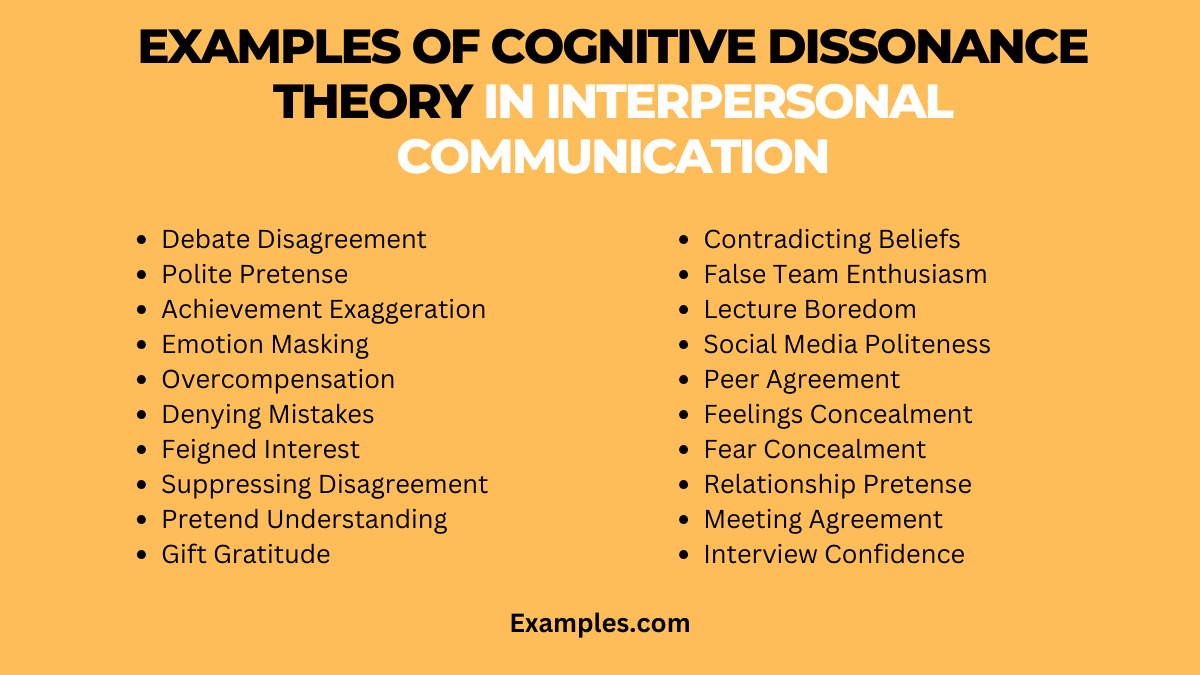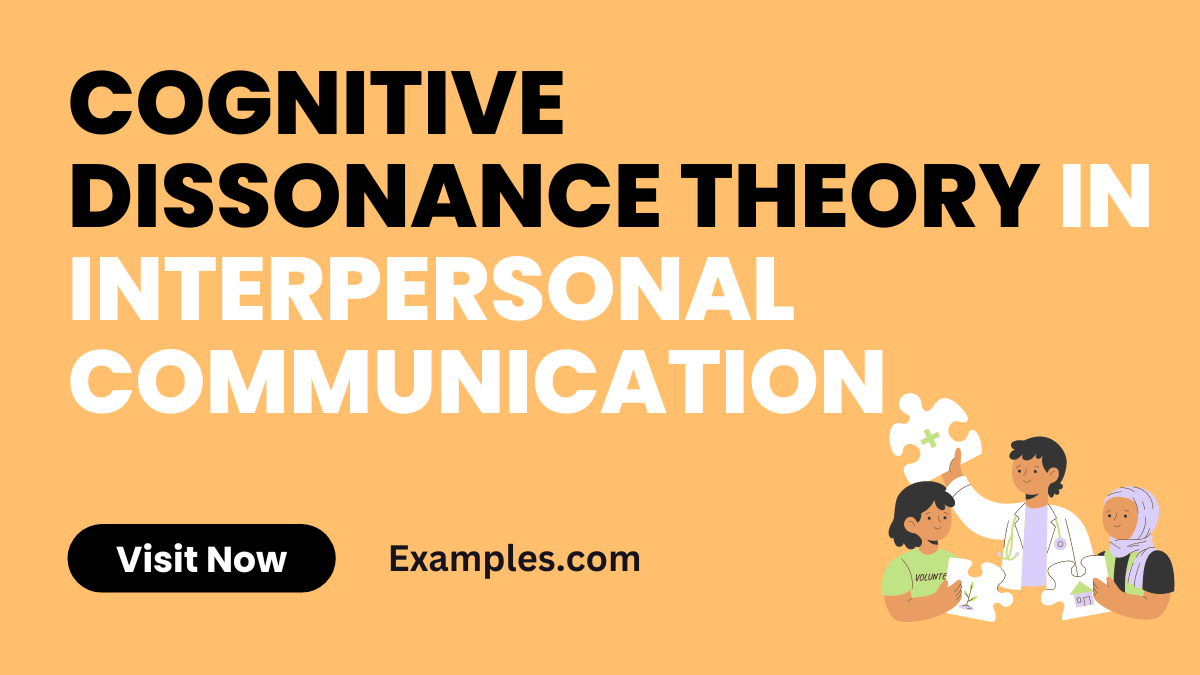19+ Cognitive Dissonance Theory in Interpersonal Communication Examples
Cognitive Dissonance Theory, a pivotal concept in interpersonal communication, delves into the mental discomfort experienced when confronted with conflicting beliefs, values, or attitudes. This comprehensive guide explores how this theory plays a crucial role in understanding and improving interpersonal dynamics. By examining the theory’s application in various communication contexts, readers can grasp its significance in resolving mental conflicts and fostering effective, meaningful exchanges. Whether it’s in personal relationships, professional settings, or social interactions, understanding Cognitive Dissonance Theory is instrumental in enhancing communication skills and emotional intelligence.
What is the Cognitive Dissonance Theory in Interpersonal Communication?

Cognitive Dissonance Theory, introduced by Leon Festinger in 1957, highlights the psychological stress experienced when an individual holds two or more contradictory beliefs, values, or attitudes, especially in the context of interpersonal communication. This theory suggests that to alleviate the discomfort of dissonance, people are motivated to change their attitudes, beliefs, or behaviors to achieve consistency. In interpersonal communication, this theory becomes particularly relevant as it influences how individuals interact, respond to conflicting viewpoints, and seek harmony in their social interactions.
History
Who Created: Leon Festinger
Date: 1950
His seminal work, “A Theory of Cognitive Dissonance,” revolutionized the understanding of human psychology and interpersonal communication. Festinger’s theory was ground breaking in elucidating how individuals strive for internal consistency, and how this pursuit impacts their interactions and decision-making processes. Over the years, this theory has been refined and expanded, providing profound insights into the complexities of human communication and psychology.
Best Example of Cognitive Dissonance Theory in Interpersonal Communication
A classic example of Cognitive Dissonance in interpersonal communication can be observed in workplace settings. Imagine an employee who values honesty but is asked to misrepresent facts in a client meeting. The conflict between their personal value of honesty and the need to comply with workplace demands creates cognitive dissonance. To resolve this dissonance, the employee might rationalize the situation by adjusting their beliefs about honesty in professional contexts, thereby reducing the psychological discomfort and achieving a sense of internal consistency.
20 Examples of Cognitive Dissonance Theory in Interpersonal Communication

Cognitive Dissonance Theory, a pivotal concept in Interpersonal Communication, reveals the internal conflict we experience when our beliefs clash with our actions. This article explores 20 diverse examples, showcasing how this theory manifests in various forms of Interpersonal Communication, including verbal, non-verbal, and digital interactions. Each example illustrates the complexity of human communication and the psychological discomfort of cognitive dissonance, offering insights into how we navigate conflicting thoughts and communications in our daily lives.
- Agreeing to Disagree in a Debate: Despite personally disagreeing with a point, you verbally agree in a group discussion to avoid conflict. “Though I have my reservations, I see your point.”
- Forced Politeness in Unwanted Conversations: Engaging in polite conversation with someone you dislike, masking your true feelings. “It’s always nice talking to you.”
- Exaggerating Achievements: Overstating your success in a conversation, despite knowing the truth. “I led the project to a huge success.”
- Hiding True Emotions in Public Speaking: Presenting a confident front in public speaking despite feeling insecure. “I am thrilled to be here today.”
- Overcompensating in Digital Communication: Sending overly cheerful texts when you’re actually upset. “I’m doing great, thanks for asking!”
- Denying Mistakes in Small Group Communication: Insisting you’re right in a team meeting, despite knowing you made a mistake. “I am certain my approach was correct.”
- Feigning Interest in Networking Events: Showing interest in a conversation at a networking event, despite feeling bored. “That’s fascinating, tell me more!”
- Suppressing Disagreement in Relationship Talks: Hiding disagreement in a relationship to maintain peace. “Yes, that sounds like a good idea.”
- Pretending to Understand in Class: Acting like you understand a concept in class to avoid embarrassment. “Yes, I completely get it.”
- Masking Disappointment in Gift Receiving: Showing gratitude for a gift you don’t like. “This is exactly what I wanted, thank you!”
- Contradicting Beliefs in Work Conversations: Expressing agreement with a company policy you internally disagree with. “I think the new policy is great.”
- Displaying False Enthusiasm in Team Projects: Feigning excitement about a team project you’re not interested in. “I can’t wait to start working on this!”
- Hiding Boredom in Lectures: Pretending to be engaged in a lecture while feeling bored. “This topic is so interesting.”
- Concealing Dislike in Social Media Interactions: Liking a social media post you actually disagree with. “Great post, totally agree!”
- Forced Agreement in Peer Discussions: Agreeing with friends’ opinions to avoid arguments, despite disagreeing. “You’re right, that makes sense.”
- Downplaying Feelings in Emotional Expression: Understating your sadness in a conversation to appear strong. “I’m just a little upset, it’s nothing.”
- Concealing Fear in Public Communication: Hiding your fear while speaking publicly on a topic you’re unsure about. “I’m fully confident in my insights on this matter.”
- Pretending to be Happy in Relationship Communication: Acting happy in a relationship to avoid addressing issues. “Everything’s perfect with us.”
- Feigning Agreement in Professional Meetings: Nodding along to a superior’s opinion in a meeting, despite disagreeing. “I completely agree with your perspective.”
- Displaying False Confidence in Job Interviews: Showing confidence in a job interview, while feeling doubtful about your qualifications. “I am the perfect candidate for this role.”
Perspectives of Cognitive Dissonance Theory in Interpersonal Communication
- Conflict Between Beliefs and Actions: Cognitive dissonance theory highlights the inner conflict individuals experience when their beliefs clash with their actions during Interpersonal Communication. This dissonance often leads to discomfort, prompting a change in either behavior or beliefs to restore harmony.
- Self-Perception and Attitude Change: In Interpersonal Communication, cognitive dissonance influences how individuals perceive themselves and others. When faced with contradictory actions and beliefs, people tend to adjust their attitudes to align with their actions.
- Role of Rationalization: To mitigate the discomfort of cognitive dissonance in Types of Interpersonal Communication, individuals often rationalize their behavior. This rationalization helps in justifying actions that might otherwise seem inconsistent with their beliefs.
- Impact on Decision Making: Cognitive dissonance theory plays a critical role in decision-making processes in interpersonal interactions. After making a choice, individuals might experience dissonance if new information challenges their decision, leading to a reassessment of their choice.
- Influence on Relationship Dynamics: In relationships, cognitive dissonance can affect how individuals interact and communicate. The tension arising from conflicting beliefs and actions can lead to changes in communication patterns and relationship dynamics.
What are the Elements of Cognitive Dissonance Theory in Interpersonal Communication?
- Belief Discrepancy: The core element of cognitive dissonance in Interpersonal Communication is the discrepancy between an individual’s beliefs and their actions or experiences.
- Psychological Tension: Cognitive dissonance creates a state of psychological tension that individuals are motivated to resolve. This tension is a driving force behind changes in beliefs or behaviors.

- Rationalization Processes: The use of rationalization to justify actions or beliefs that are in conflict is a key element in managing cognitive dissonance in Interpersonal Communication.
- Impact on Self-Identity: Cognitive dissonance affects an individual’s self-identity, especially in social contexts. The way one resolves dissonance can significantly influence their self-perception and identity.
- Role of Culture and Social Norms: Cultural beliefs and social norms play a crucial role in shaping how cognitive dissonance is experienced and resolved in Interpersonal Communication. Different cultures may have varying thresholds for dissonance and different methods for its resolution.
Strategies Humans Use to Overcome Cognitive Dissonance Theory in Interpersonal Communication
- Seeking Consistency: Individuals often strive to maintain consistency in their beliefs and actions during Interpersonal Communication. When faced with cognitive dissonance, they might change either their beliefs or actions to align with each other.
- Selective Exposure to Information: People tend to seek information that confirms their existing beliefs and avoid information that causes dissonance. This selective exposure is a common strategy in managing cognitive dissonance in various Interpersonal Communication Examples.
- Reframing Situations: To overcome cognitive dissonance, individuals may reframe situations or reinterpret information in a way that reduces conflict between beliefs and actions.
- Changing Beliefs or Behavior: One direct approach to resolving cognitive dissonance is to change either the conflicting belief or the behavior causing the dissonance. This change helps in achieving internal harmony.
- Seeking Social Support: Engaging in conversations and seeking support from others can help in resolving cognitive dissonance. Social interactions provide different perspectives and reassurance, aiding in the reconciliation of conflicting beliefs and actions.
Cognitive Dissonance Theory is vital for effective interpersonal communication. This guide and its accompanying tips provide valuable insights into addressing and managing cognitive dissonance in communication. By encouraging self-awareness, promoting open dialogue, and offering constructive solutions, individuals can navigate conflicts and inconsistencies, ultimately fostering healthier and more authentic interpersonal relationships.



